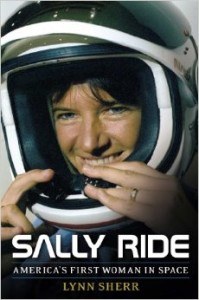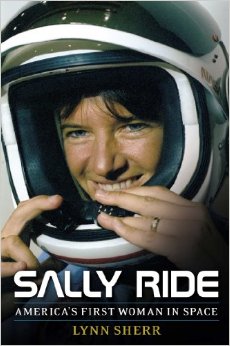 Sally Ride: American’s First Woman in Space
Sally Ride: American’s First Woman in Space
by Lynn Sherr
Simon & Schuster. 341 pages, $28.
IT WAS only one sentence in a lengthy obituary of America’s first female astronaut, but it momentarily overshadowed Sally Ride’s inspirational life. “Dr. Ride is remembered by her partner of 27 years, Tam O’Shaughnessy,” it read, and you could practically hear readers gasp in surprise. Almost no one outside of her immediate family realized that Sally Ride: America’s First Woman in Space, was in a long-term relationship with another woman.
This is how Ride wanted it, according to Lynn Sherr’s vigorous new biography, written after Ride died of pancreatic cancer at age 61 in 2012. Sherr, a journalist who anchored ABC’s coverage of NASA’s space program in the early 1980s, befriended the astrophysicist as she trained for her first shuttle mission. Like the rest of America, Sherr was captivated by the brilliant, optimistic woman who seemed destined for the stars.
Growing up in southern California in the 1960s and ’70s, Sally Ride was a nationally ranked tennis champ who spent her time off the court studying Shakespeare, physics, and astronomy. By the time she entered Stanford with a major in physics—the only woman in the department—she had decided that science, not sports, would be her career. She also met her first serious girlfriend, a fellow tennis semi-pro. Sherr doesn’t speculate as to whether Ride’s reticence about her sexuality originated in the women’s tennis circuit, but she was undoubtedly aware of the negative reaction when her mentor, Billie Jean King, came out in 1981.
By then, Ride was ensconced in the ultra-macho milieu of NASA. When she and six other women were accepted into the Space Shuttle program in 1978, journalists asked them ridiculous questions—“How will you apply makeup in space?”—and late-night comedians made the “astronettes” the butt of insulting jokes. The clueless team at NASA responsible for packing the astronauts’ toiletry kits asked Ride if she thought 100 tampons would be enough for their six-day mission, just in case.
On June 18, 1983, Ride buckled into the Challenger’s cockpit for liftoff. Years later, she would describe “the psychological and emotional feelings that come along with the actual launch … fueled by the realization that you’re … sitting on top of tons of rocket fuel and it’s basically exploding underneath you. It’s an emotionally and psychologically overwhelming experience. Very exhilarating. Exhilarating, terrifying and overwhelming all at the same time.” On the brief mission, Ride operated the giant robot arm that lifted satellites out of Challenger’s cargo bay and set them into orbit. She and a fellow astronaut also rigged a camera to take a picture of the shuttle against a backdrop of Earth’s horizon—the first space selfie.
When she returned to earth, Sallymania swept America. She went to Disney World, gave hundreds of interviews, had lunch with President Reagan, and endured criticism from the press when she allegedly refused to accept a bouquet of flowers. Ride bore it all with humor, but the experience showed her how far female scientists, and women in general, had to go to achieve equal footing with men. After retiring from NASA in 1987, she taught physics at UC-San Diego and set up house with Tam O’Shaughnessy, whom she had known since she was a teenager. Together they founded Sally Ride Science, a company that produced educational products geared toward girls “to make science cool again.” But she never felt free enough to come out, even to her closest colleagues in academia or at her own company. She jumped from one insular community to the next, maintaining an ironclad shell around her private life.
This entertaining and informative biography uses interviews from dozens of Ride’s childhood friends, college pals, NASA colleagues and family, and even her ex-husband, fellow astronaut Steve Hawley, whom she married in 1982 and divorced in ’87. (Note the prominent wedding ring she sports on the book jacket photo.) Ride left virtually no diaries or letters that revealed her private thoughts. Sherr certainly faced a challenge in writing an accurate account of a woman who resisted any writer’s attempt to delve into her compartmentalized life while she was alive.
Ride’s reasons for remaining in the closet even after she left NASA—and even after her friends had put two and two together—are not entirely clear. Sherr doggedly interviewed Ride’s first serious girlfriend, her ex-boyfriends, and her ex-husband, asking if they had an inkling of her motives for such secrecy. But the world-famous astronaut remains inscrutable to her closest family and friends—including Sherr—and certainly to readers of this book. In 2013, President Obama named Sally Ride a posthumous recipient of the Presidential Medal of Freedom, the nation’s highest civilian honor, for her contributions to science and women’s leadership.
________________________________________________________
Kat Long is a freelance science writer and a Master’s candidate at the CUNY Graduate School of Journalism.






